The fire is still burning. Smoke continues to rise from the canyon rim. But for the first time since the South Rim Fire ignited at Black Canyon of the Gunnison National Park on July 10, crews reported measurable progress: 14% containment as of Friday morning.
Officials with multiple agencies, including the national park, Rocky Mountain Incident Management, the BLM and Montrose County, opened the gates to the national park for the first time in more than a week, leading media through scorched portions of the park to witness what’s been lost — and what was saved.
The tour was led by Bethany Urban, public information officer for the incident management team, who guided Friday’s briefing and pointed out the methods firefighters used to protect infrastructure, especially the still-standing visitor center.
Heavy equipment near the burned-down maintenance building was also burned at the park. (Gunnison Clamp for the MBT)
“This is actually a really great example of what we sometimes have to do to protect a structure,” Urban said, gesturing to the burned out brush next to the Visitor Center. “As you can see, this visitor center is still standing. One of the reasons is because firefighters were able to get in here, clear out some of this brush, put in hose lays to get water access, and they were actually able to help burn out around this building a little bit.”
Some call it “fighting fire with fire.” Urban said the technique — known as a burnout — helped keep flames from racing to the building’s foundation by removing fuel ahead of the approaching fire.
“When fire hits black — already burned — area, often it will stop burning,” she said. “Not always, but that’s our hope. And that’s why you hear us talk about doing burning out around a structure.”
The strategy worked. While the building was saved, the surrounding landscape bears the weight of what passed through.
The campgrounds are scorched, many of the fiberglass tabletops at campsites completely gone. Some trees are nothing but stumps now, with white ash pooled at the base. Along the ridges, dust devils and “smoke-nados” spiral through the charred remains of piñon and juniper.
The canyon itself remains largely unchanged. The views are still there. But the South Rim, where most visitors spend their time, has burned. Notably, a lookout deck at Tomichi Point is completely gone. But beyond that, in the canyon itself, the views are still immaculate, even while smoke billows over the horizon.
“About 80% of the South Rim burned,” said Park Superintendent Stuart West, who spoke during Friday’s tour. “The good news is the public is safe and all the park staff is safe… but where the heaviest park use is — that’s what got hit.”
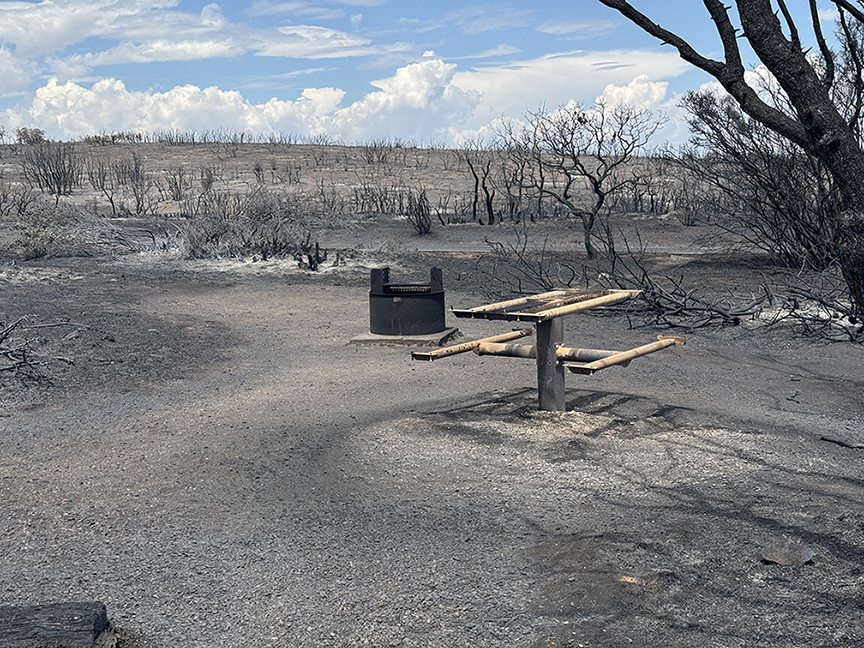
A destroyed campsite with scorched trees and vegetation surrounding. (Justin Tubbs | MBT)
Though the fire has burned just 12% of the park’s total acreage, it has damaged key infrastructure. The park’s maintenance building — home to tools, vehicles, and a fire and wood shop — was destroyed along with some of the equipment stored inside. Six restroom stations in the campground and one at the Pulpit Rock overlook were also lost.
“We started moving as much equipment down the hill as we possibly could,” West said. “But some of it didn’t make it out.”
Crews From Across the Country, No Injuries Reported
Urban emphasized that no firefighters or civilians have been injured during the fire so far. That’s no small feat, given the complexity of the response and the geography involved.
“We have crews from everywhere,” she said. “We have a lot of local crews in the Colorado area. We also have regional crews from across the state and people here from Kansas, Arizona, Idaho, Missouri — quite frankly, across the country.”
Urban said the fire now has about 450 personnel assigned, including hand crews, engines, helicopters, and support staff.
“Initially, you have those initial attack resources that are local,” she said. “But as this organization grows, we start utilizing national resources.”
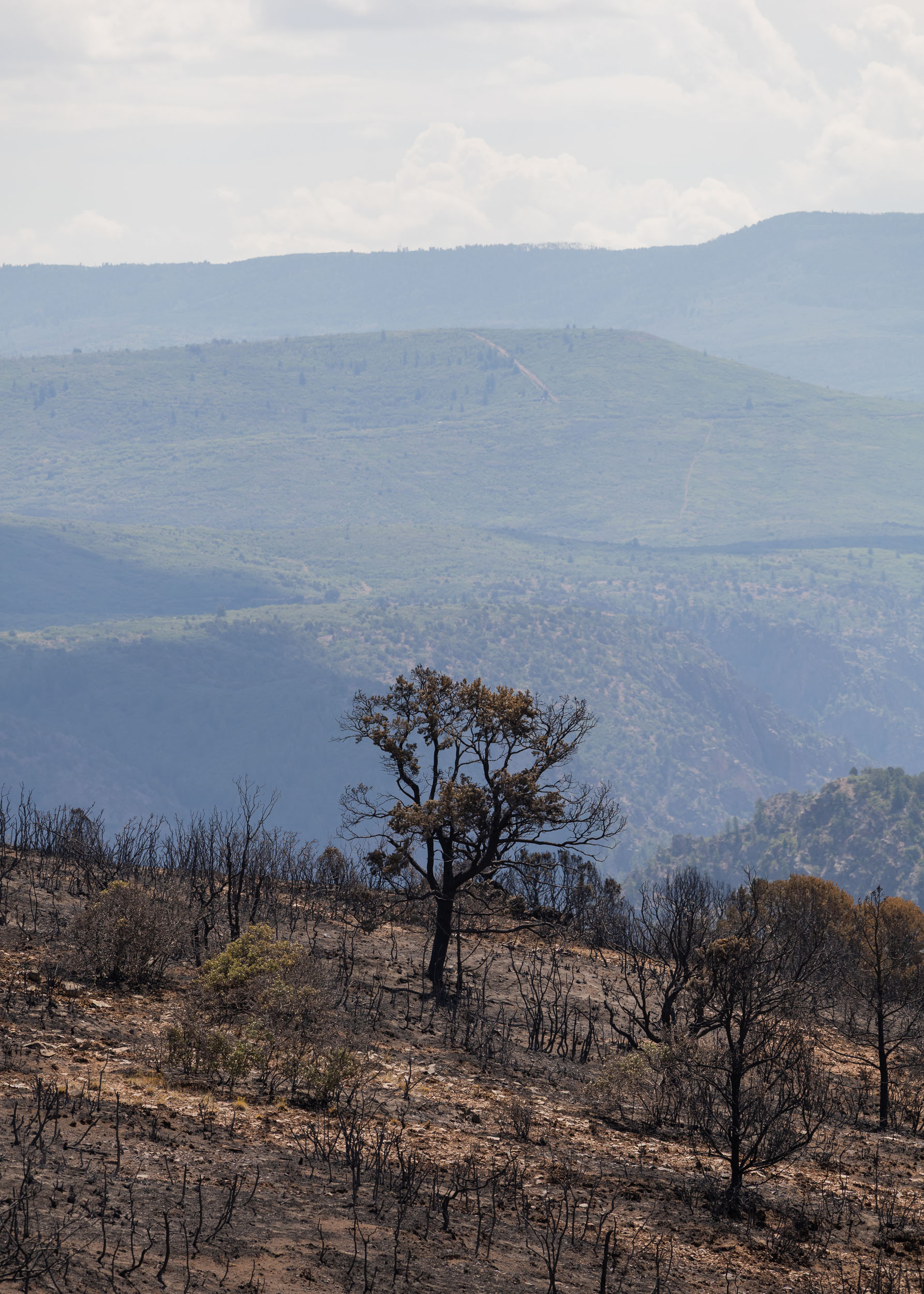
Some burned landscape at the South Rim of the Black Canyon of the Gunnison National Park. (Gunnison Clamp for the MBT)
Crews are now working long days across the fire lines — especially the northwest and southeast corners, where heat remains active. In some areas within the canyon that are tough to get to, fire will likely continue to smolder.
“We’re still going to have smoke,” said Jay Miller, the incident commander. “This fire is interesting because of the topography and the actual canyon itself. With the inaccessibility of the rim and anything below the rim, we’re not going to be able to put boots to the ground in some areas.”
Where firefighters can safely operate, suppression efforts continue — a mix of dozer lines, hand lines, and aerial ignition, all aimed at controlling spread and protecting “values at risk.”
Those values, Miller explained, include infrastructure like the Crystal Dam and the Gunnison Tunnel, cultural sites, park buildings, private property, and natural resources.
6–7 Park Workers Relocated, Bostwick Park Still Under Evacuation
At the time of the fire, six to seven seasonal park employees were living within the South Rim. All were evacuated safely and have since been relocated to Curecanti National Recreation Area, which remains fully open to visitors.
West said those employees are now assisting operations at Curecanti and at federal offices in Montrose.
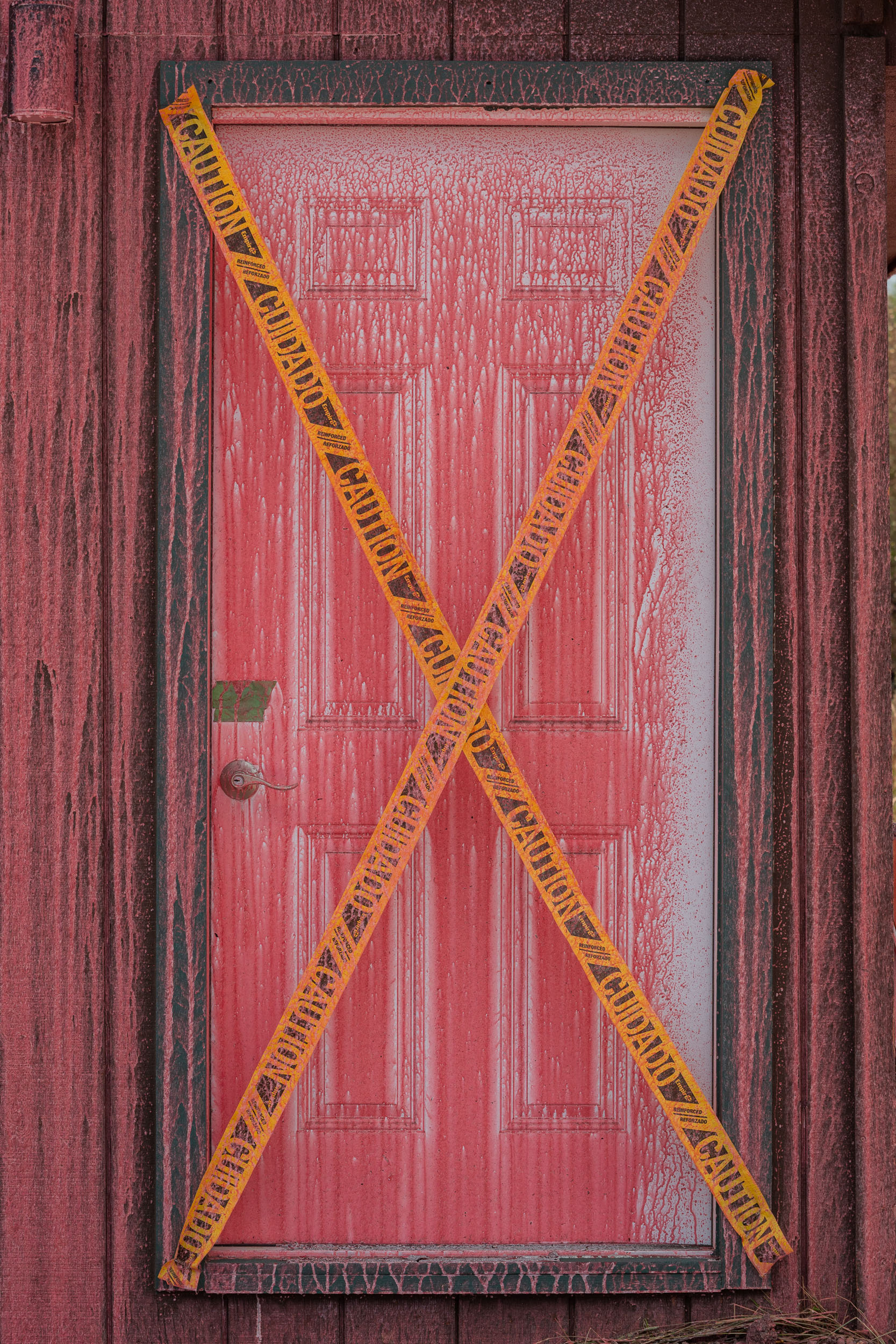
A building utilized by park staff is covered with retardant, the door taped off. (Gunnison Clamp for the MBT)
Outside the park, evacuations remain in place for parts of Bostwick Park and several nearby roads. Officials said about 90 homes were initially evacuated and around 200 residents displaced.
“We’re working with the folks on the fire to get that line above those homes secured,” said Montrose County Emergency Manager Scott Hawkins. “We just don’t want to put people back in their homes prematurely and then have to re-evacuate them.”
No homes have been lost, Hawkins confirmed. Livestock was also successfully evacuated by residents, many of whom made multiple trips before the fire arrived.
“The community’s been amazing,” he said. “People opened up their pastures, gave folks a place to stay… It’s really been kind of neat to see that community support.”
Montrose County used a layered notification approach during evacuations — sending alerts via its emergency system, going door-to-door with law enforcement, and triggering Integrated Public Alert and Warning System (IPAWS) messages that reach every phone in a defined zone.
Protecting Water, Wildlife — and the Local Economy
Though the fire hasn’t reached the Gunnison River, officials are preparing for the possibility of ash and debris washing into waterways during future rains. Those waters are vital — they feed the Gunnison Tunnel, supply drinking water, and irrigate more than 77,000 acres of farmland in Montrose and neighboring counties.
“We are concerned about that a little bit,” Hawkins said. “We’re taking measures now to keep post-fire debris from affecting the Crystal Dam and the diversion dam.”
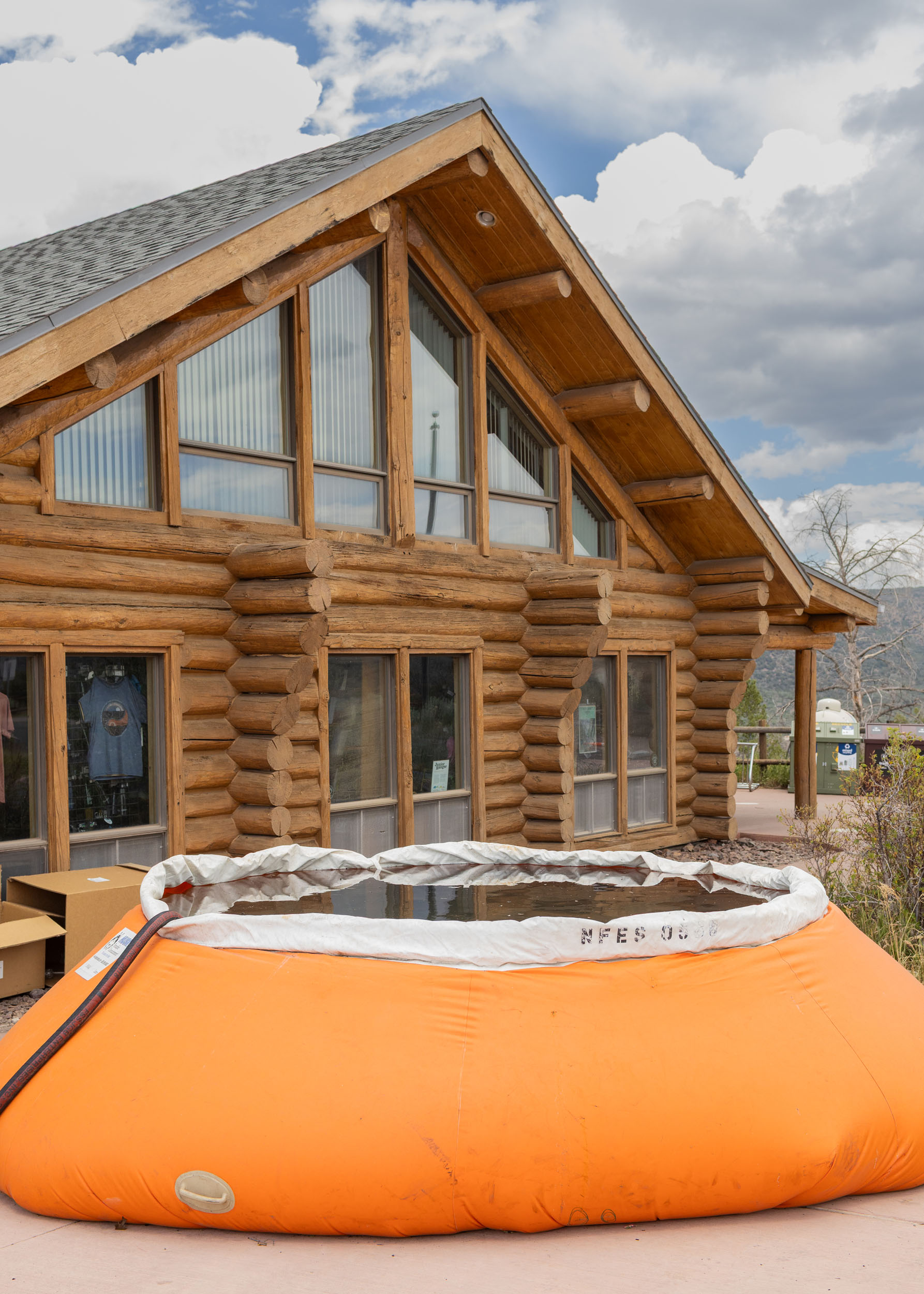
A portable tank holds water in case of a flare-up near the Visitor Center. (Gunnison Clamp for the MBT)
Fish habitat is also a concern, as is the endangered sage grouse population on the North Rim. While the fire has not crossed the canyon, officials are keeping a close eye on that possibility.
Economically, the park’s closure is already being felt, though it’s too early to tell just how much. Black Canyon of the Gunnison National Park generates an estimated $32 million annually for the region’s economy.
“That’s why the county signed a disaster declaration,” Hawkins said. “It’s not just about funding — it’s about accessing the resources we need for recovery.”
$6.2 Million and Counting
The cost of fighting the fire is already estimated at $6.2 million. That number includes personnel, equipment, aerial support, and logistics. How that cost is split between agencies is still being negotiated.
“Typically when we have large fires that affect multiple jurisdictions, there’s a cost-share negotiation,” said Miller. “That can be based on acres burned, percent of effort — it really depends on the agency administrators involved.”
Jurisdictions include the National Park Service, Bureau of Land Management, Montrose County, and the Bureau of Reclamation.
No Timeline Yet for Reopening
There is no set timeline for reopening the park. West said any reopening would likely happen in stages — roads first, then possibly overlooks, and eventually trails and campgrounds.
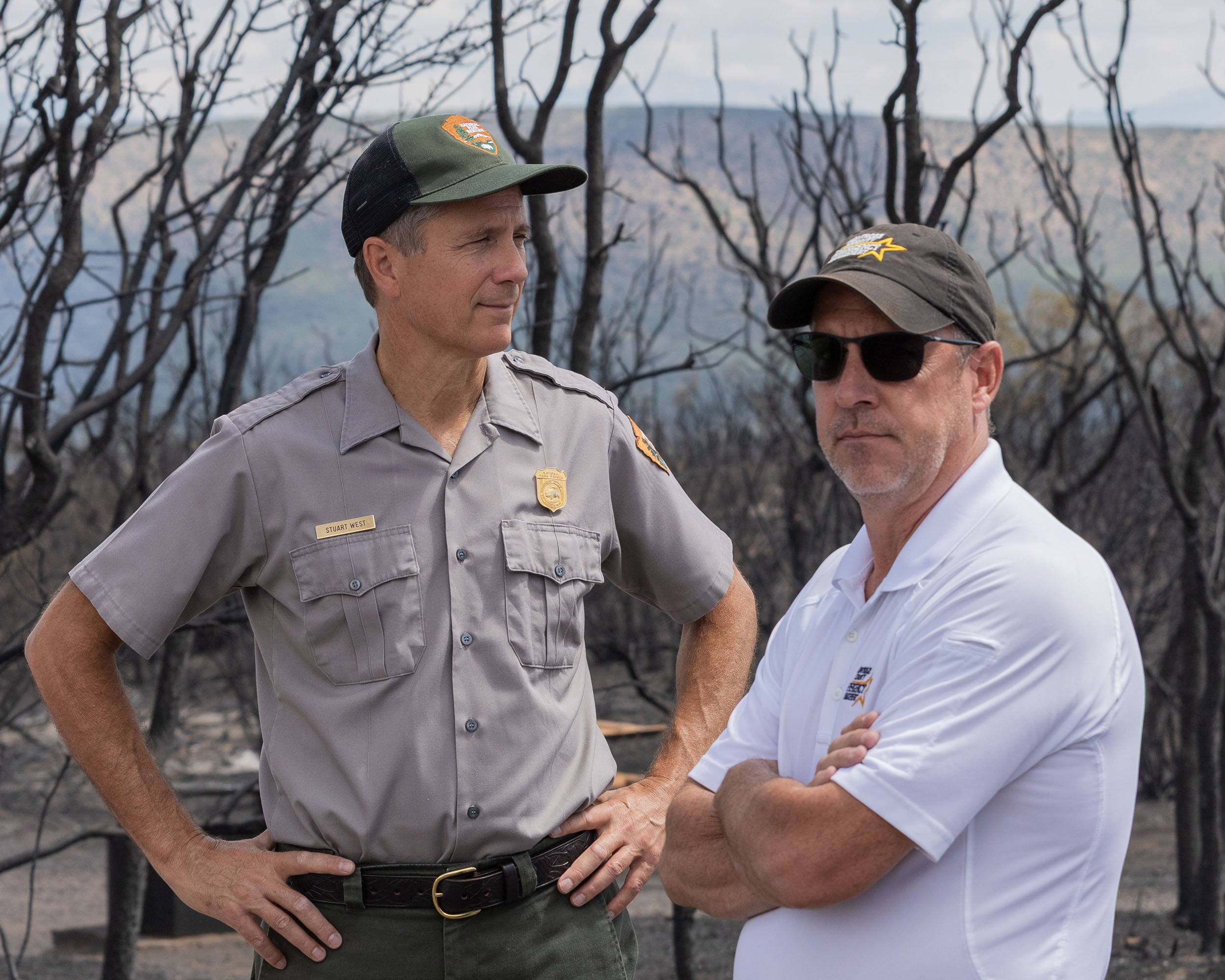
Park Superintendent Stuart West, left, and Montrose county Emergency Manager Scott Hawkins at a stop during the media tour of the Black Canyon National Park on Friday.. (Gunnison Clamp for the MBT)
“We’re not taking any more campground reservations,” West said. “It would almost be like camping in an ash pit.”
Before anything reopens, crews will need to assess safety hazards: burned-out trees, damaged railing, and unstable terrain.
Still, officials encouraged travelers to consider nearby alternatives.
“Our sister park, Curecanti National Recreation Area, is completely unscathed,” West said. “If you have travel plans and you’re ready to come out here, go to Curecanti. All the facilities are open, and it’s a great place to visit.”
Rusty Stark, with the BLM fire management team, which initially responded to the fire, said it’s been years since he’s needed a critical incident management team in his southwest district. His team puts out fires usually before they get out of hand.
This one was one of several to which his team responded on July 10, but the South Rim Fire just got away from them too quickly. A separate fire, on the north end, was extinguished shortly after it sparked the same day.
But Stark, asked about the firefighters’ efforts at the park, said, “Everything (they do) everyday is remarkable. The effort of these firefighters is incredible.”
Justin Tubbs is the editor for the Montrose Business Times. Email him at justin@montrosebusinesstimes.com or text or call at 254-246-2260.
